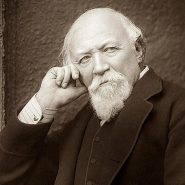Let the bird of loudest lay,
On the sole Arabian tree,
Herald sad and trumpet be,
To whose sound chaste wings obey.
But thou, shrieking harbinger,
Foul precurrer of the fiend,
Augur of the fever’s end,
To this troop come thou not near.
From this session interdict
Every fowl of tyrant wing,
Save the eagle, feather’d king:
Keep the obsequy so strict.
Let the priest in surplice white,
That defunctive music can,
Be the death-divining swan,
Lest the requiem lack his right.
And thou treble-dated crow,
That thy sable gender mak’st
With the breath thou giv’st and tak’st,
’Mongst our mourners shalt thou go.
Here the anthem doth commence:
Love and constancy is dead;
Phoenix and the Turtle fled
In a mutual flame from hence.
So they loved, as love in twain
Had the essence but in one;
Two distincts, division none:
Number there in love was slain.
Hearts remote, yet not asunder;
Distance, and no space was seen
’Twixt this Turtle and his queen:
But in them it were a wonder.
So between them love did shine,
That the Turtle saw his right
Flaming in the Phoenix’ sight:
Either was the other’s mine.
Property was thus appalled,
That the self was not the same;
Single nature’s double name
Neither two nor one was called.
Reason, in itself confounded,
Saw division grow together;
To themselves yet either neither,
Simple were so well compounded.
That it cried, “How true a twain
Seemeth this concordant one!
Love hath reason, reason none,
If what parts can so remain.”
Whereupon it made this threne
To the Phoenix and the Dove,
Co-supremes and stars of love,
As chorus to their tragic scene:
Beauty, truth, and rarity,
Grace in all simplicity,
Here enclosed in cinders lie.
Death is now the Phoenix’ nest,
And the Turtle’s loyal breast
To eternity doth rest,
Leaving no posterity:—
’Twas not their infirmity,
It was married chastity.
Truth may seem, but cannot be;
Beauty brag, but ’tis not she;
Truth and beauty buried be.
To this urn let those repair
That are either true or fair;
For these dead birds sigh a prayer.
Originally published in 1601 in Love’s Martyr, attributed to William Shakespeare. Public domain.
Analysis
Introduction
“The Phoenix and the Turtle” is among Shakespeare’s most enigmatic and philosophical poems, first printed in 1601 within Robert Chester’s anthology Love’s Martyr. The poem combines elegy, allegory, and metaphysical reflection, mourning the mystical union and death of two birds — the Phoenix and the Turtle Dove — who represent idealized love and spiritual unity.
Though brief, this work is one of Shakespeare’s most profound meditations on love, identity, and transcendence.
Summary of the Poem
The poem unfolds as a funeral rite. A chorus of birds gathers to mourn the death of the Phoenix and the Turtle, whose “mutual flame” symbolizes perfect and selfless love. Their union was so complete that “two distincts, division none,” meaning that individuality was dissolved in spiritual oneness.
The threnody (lament) that follows celebrates their purity, truth, and constancy, lamenting that such perfection cannot exist in a corrupt world. Their death, therefore, marks both an ending and an apotheosis — their spirits united eternally beyond the physical.
Themes and Interpretation
Ideal Love and Unity: The poem presents love as a mystical fusion that transcends individuality. The Phoenix (a symbol of rebirth) and the Turtle Dove (symbol of fidelity) embody perfect constancy: “Two distincts, division none.” Their love annihilates separation — a metaphysical union of spirit and essence.
Death and Transcendence: The birds’ death is not tragic in a mortal sense but transformative. Through death, their ideal love achieves eternity. The poem’s paradox — that they “die to live” — anticipates later metaphysical poetry by John Donne.
Truth, Beauty, and Purity: In the closing threne, Shakespeare mourns the loss of absolute values. With the lovers’ death, “Truth and beauty buried be,” suggesting that in a fallen world, purity and perfection cannot endure.
Style and Language
The poem is written in short, controlled stanzas, alternating between invocation, allegory, and lament. The rhythm is ritualistic, befitting its ceremonial tone. Shakespeare’s compression of metaphysical ideas into musical phrasing — “Either was the other’s mine” — produces a sense of mystery that invites endless interpretation.
The combination of religious imagery and erotic symbolism — chastity, fire, unity, resurrection — reveals a Renaissance fascination with the blending of body and soul, faith and desire.
Symbolism and Allegory
The Phoenix and the Turtle Dove have been interpreted in many ways: as allegories of divine love, ideal friendship, or even political unity (some scholars associate them with Queen Elizabeth I and the Earl of Essex). Yet the poem resists fixed meaning. Its power lies in abstraction — a pure elegy for perfection lost.
The burning of the lovers in “a mutual flame” evokes both passion and purification, turning physical love into spiritual transcendence.
Legacy and Influence
Although obscure in its imagery, “The Phoenix and the Turtle” has inspired centuries of commentary. Critics from T. S. Eliot to W. H. Auden have praised its austere beauty and philosophical daring. It bridges Shakespeare’s lyrical early style with the metaphysical intensity of the seventeenth century.
Today, it stands as one of English literature’s most haunting short poems — a meditation on the paradox of love: that true unity may only be achieved through dissolution.

